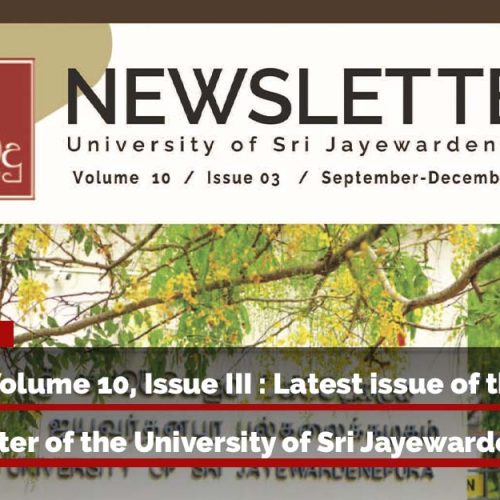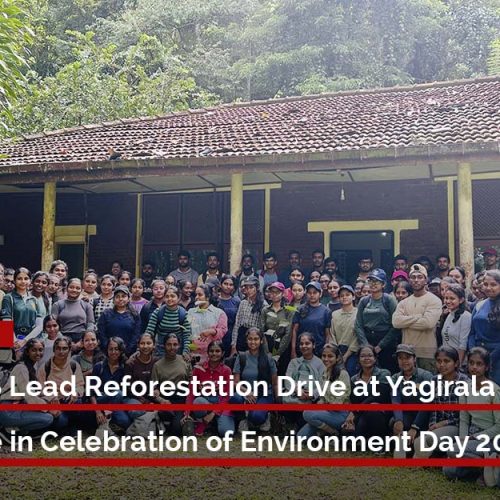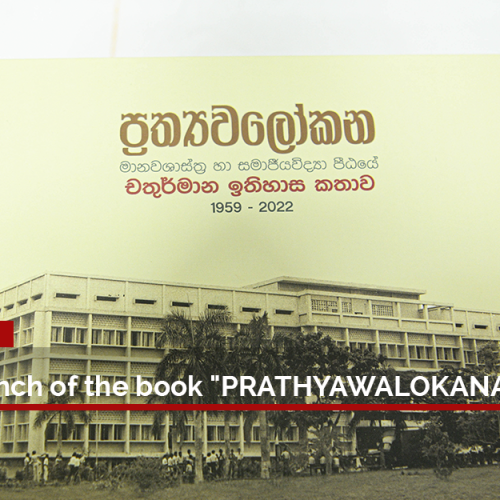In the past couple of years from time to time the toque macaques or commonly known as rilawa, became the target for many discussions because of the reports indicating them as a prominent species responsible for crop damage which cause considerable economic loss to the farmers in many parts of the country. Many of these reports published by various organizations on the estimation of the damage caused by macaques and the population density of macaques were not based on standard scientific methods and are not accurate. However, the relevant authorities are trying to find various solutions to control the situation based on these reports which most of the time are detrimental to the monkeys and trigger objections from the concerned parties. The macaques once again became a hotly debated topic recently and made headlines in many social media platforms because of the news alert stating that the authorities are removing the macaques and few other animal species that are reported to damage crops from the legally protected list. However, macaques were never on the legally protected list of animals under the Fauna and Flora Protection Act and hence the public were misinformed by various parties.
Very recently macaques are highlighted again in the headlines of all the social media due to the reports that the Ministry of Agriculture is considering the request made by a Chinese delegation and looking into the possibilities and legal aspects of exporting around one hundred thousand macaques to Zoological Gardens in China. This news created a media frenzy, and many people are writing for and against this. There are both positive and negative aspects if this materializes and both aspects should be considered thoroughly before taking any action. Removal of a large number of animals from an area at any given time could impose serious environmental issues by disrupting the ecological balance and should be done under intense supervision after a thorough scientific investigation. The macaques, with the rest of the animal species play a crucial role in preserving the biodiversity and they help to maintain the biological balance by contributing to the natural biological control of species and to help in seed dispersal. In Sri Lanka there are three subspecies of macaques and each subspecies can be found only in a particular climatic zone such as in the wet zone (wet zone sub species), dry zone (dry zone sub species which has the widest distribution) and the highlands (highland subspecies). There are no accurate population estimation records of these subspecies. Therefore, it is important to estimate the correct population sizes of these subspecies and if the authorities are going ahead with the plan then should scientifically decide the number of animals to be removed from each subspecies from a certain location by making sure to keep a viable population in the environment. Further handling of such a large number of monkeys by untrained people could impose health risk due to the transmission of zoonotic and anthroponotic diseases. The relevant authorities have to consider all these factors before taking any decisions. According to these reports the estimated macaque population in the country is three million which is an over estimation of the macaque population and the authority who came up with this number should explain the reliability of this estimation.
In reality, there seems to be neither accurate population estimation of the macaques in the country nor the estimation of economic loss due to crop damage by macaques alone. According to the ground situation in each area most often more than one species of animal is responsible for damaging crops. However, when estimating the crop damage, the damage caused by the less conspicuous species, and the damage caused by the nocturnal animals (as people could not see the occurrence of the damage at night) were often overlooked and the entire loss of harvest get credited to the predominant crop damaging species present in that area. All these factors contribute to obtaining inaccurate data if not collected scientifically.
The world situation
According to the published sources toque macaque species endemic to Sri Lanka cause considerable damage to crops in many places that they can be found however, this problem is not a limited only to our country. When we consider the global situation, there are more than 20 species of macaques in the world. Other than one species (Barbary macaque) found in North Africa the rest are widely distributed throughout the Asian countries from Afghanistan to Japan, the Philippines and Indonesia. Though countries like Sri Lanka (toque macaque), Japan (Japanese macaque) and Taiwan (Formosan macaque) has only one species of macaque, most of other Asian countries harbor several species of macaques i.e. India (rhesus macaques, bonnet macaques, lion-tailed macaques, Assam macaques, Arunachal macaques, stump-tailed macaques, pig-tailed macaques) and Thailand (Assam macaques, pig tailed macaques, long-tailed macaques, rhesus macaques, stump-tailed macaques). What all these countries have in common is that they all are facing this human macaque conflict due to crop damage by the macaques to varying degrees and each are using various measures to mitigate the issue.
Therefore, Sri Lanka too as a country should examine how the neighboring countries are tackling this problem without taking drastic measures to control the situation to get short term temporary solutions. It is important to identify long term and short-term measures to sustainably mitigate the issue and implement them simultaneously which will help farmers to reduce the crop loss due to macaques and to control the macaque population to conserve these endemic monkey species and to preserve the biodiversity in the long run. Other counties too practice the population control methods successfully using scientific methods to reduce crop damage caused by macaques to help famers and Sri Lanka too should adopt these strategies to control the issue that will bring a win-win situation both for the farmers as well as for the monkeys. None of this will be possible without having accurate data on their population density and the correct estimation of the economic loss. The most crucial step in managing the issue is to map out the actual distribution of the macaques throughout the country and scientifically estimate population density and crop damage to prepare a database with the help of the relevant experts. Reliable data obtained through this way could be used to implement the identified control strategies to achieve successful and sustainable results. This could not be carried out by one individual or an organization and need all the relevant stakeholders (primate experts, relevant ministries, and government departments such as Ministry of Environment, Agriculture and the Department of Wildlife Conversation) and a coordinating body to govern the procedures with powers.
The science of studying monkeys is called primatology, Primatology is the study of the behavior, biology, evolution, and taxonomy of nonhuman primates. It is a diverse discipline at the boundary between zoology and anthropology. Primatologists study both living and extinct primates in their natural habitats and in laboratories by conducting field studies and experiments to understand aspects of their behavior and evolution. In Sri Lanka the field primatology is not well developed however there are handful of very well-trained primate specialists actively engaged in primate studies working in the universities and other organizations. Their knowledge can be used in this situation as they are the experts with an understanding of the primates and their behaviors unfortunately their services were not yet taken by the relevant authorities.
As a specialist in primatology, who has been trained to study these monkeys and their behaviors and conducting research on them for over 20 years, I was following this information circulating on the media and noticed that some of them are not correct to my understanding. Therefore, I thought of writing this article to give a wider understanding to the readers on macaques in Sri Lanka and the prevailing issue of human primate conflict.
Who are macaques?
The macaques belong to the group of mammals known as primates and are endemic to Sri Lanka. It is important to understand that we too belong to this primate group. In Sri Lanka, there are five species of non-human primates namely the;
- toque macaque (Macaca sinica with three sub species – rilawa)
- purple – faced leaf langur (Semnopithecus vetulus with four sub species- kalu wandura)
- gray langur (Semnopithecus priam – hali wandura).
- two Loris spp. (Loris tardigradus and Loris lydekkarianus- unahapuluwa)
Out of the five species of primates, macaques has the widest distribution in the country. The three subspecies of macaques are distributed in different climatic zones in the country and named accordingly as
- the dry zone toque macaques – Macaca sinica sinica
- the wet zone toque macaques – Macaca sinica aurifrons
- the highland macaques – Macaca sinica opisthomelas
The human macaque interaction
Humans, macaques and langurs (wandura) share many physiological, anatomical and behavioral characteristics and thus have similar requirements to sustain themselves. Therefore, when they share the same environment a variety of interactions between them become inevitable.
Sometimes these interactions have negative impacts, and the intensity of the interactions increases when the similarity of these shared resources increases, creating competition which at times can be detrimental to one or both species.
Positive and Negative interactions of humans and primates
Non-human primates and humans maintain both positive and negative interactions. The positive interactions include deploying primates for economically beneficial activities such as harvesting coconuts, as can be seen in Thailand and also as performers to entertain. In both instances, humans gain economic benefit by interacting with these primates, which in turn creates a positive attitude towards them.
Most crucial for the survival of the primates and their conservation is mitigating adverse interactions that create negative attitudes toward primates, primarily in the form of human and non-human primate conflict over common resources. Human – primate conflict takes many forms ranging from destroying crops, damage to property, loss of life or injury to humans, the transmission of disease and death or injury to primates. Many studies have been conducted on different primate species around the world, looking at different aspects of human-wildlife conflict in order to find possible solutions to address the above mentioned issues.
Human primate conflict: the Sri Lankan context
In Sri Lanka, the three diurnal primate species are mainly responsible for such human – primate conflict, namely the toque macaque, the purple – faced leaf langur and the gray langur. The two nocturnal Loris spp. demonstrate the least interactions with humans and no conflicts have been reported between them and humans. Further, compared to langurs, macaques are sociable animals that interact frequently with humans and prefer to stay closer to human settlements. The two langur species on the other hand prefer more natural habitats and foods compared to macaques (Nahallage & Huffman 2013; Dittus et al, 2019; Nahallage 2019). In general, out of the two langur species, the purple-faced leaf langurs are strictly arboreal folivores and have the least interactions with humans in many places, however this relationship does vary across different parts of the country (Rudran 1973, 2007; Dela 2007; Dittus 2012, 2019; Nahallage 2019). The gray langur’s food selection depends on the habitat they live in. Gray langurs that occupy natural environments depend mainly on plant material and the ones in urban cities and temple areas tend to consume food given to them by pilgrims; mostly the leftover offerings at temples (Nahallage et al. 2008; Nahallage & Huffman 2013, Dittus et al. 2019).
Human-primate conflict is not a recent occurrence in the country. Robert Knox, an English traveler who was imprisoned on the island by the Kandyan King but allowed to live in various places freely within the country for about 20 years, described how macaques invaded corn fields and home gardens despite being heavily guarded by humans (Knox 1681). There were even folk poems written regarding the crop raiding of primates (Ananda 2000). At present, crop raiding occurs in all 25 districts of the country. However, the rate of crop raiding anywhere in the world depends on such things as the species of primate present in the area, the types of crops grown, seasonality, distance to the village from the forest, availability of natural foods, and the methods of crop guarding by humans (Hill 2000, 2009; Fungo 2011). However, in Sri Lanka, macaques inflict more damage to the crops than both langur species. Except for the nocturnal loris spp., all primates were considered as pests to different degrees in all the provinces in which they are found (Nahallage et al. 2008; Prasad et al. 2016; Nahallage 2019; Cabral, et al., 2018; Dittus et al. 2019; Nahallage et al., 2022). In places where all three diurnal primates exist, toque macaques damage crops the most, followed by gray langurs (Nahallage et al. 2008; Campbel – Smith et al. 2010), however in some parts of the North Central province, gray langurs cause more damage than toque macaques (Perera & Vandercone 2016).
Why is it important to protect primates in Sri Lanka
- They are endemic to the country.
All the primate species in the country are endemic and can be found naturally inhabiting only in our country, if they get extinct from our ecological zones they will be extinct from the world.
- They contribute to preserve the high biodiversity.
The twelve sub species of non-human primates contribute to make Sri Lanka as one of the biodiversity hotspots in the world.
- They help to maintain the biological balance by contributing to the natural biological control of species.
- They help in seed dispersal.
Primate species responsible for crop damage
Macaques (Rilawa) cause more damage to crops than the two langur species (Wandura).
This is mainly due to their social organization and behavioral patterns such as
- Omnivore feeding pattern.
The omnivorous macaques consume a diverse range of food items including fruits, leaves, bark, flowers, seeds, roots, cereals, insects, other invertebrates, eggs, small mammals, birds and food prepared by humans.
- Preference to live close to human habitats
Unlike the other two langur species macaques prefer to live close to human habitats and interact with them.
- Adapted to live equally on ground as well as on trees.
- Multimale – multifemale social organization pattern.
They live in large groups with several adult males, females and babies.
In places where all three primate species present, macaques cause more damage to crops than the langurs owing to their diverse food habits, larger group sizes, ability to adapt to any environmental conditions compared to the two langur species. The purple faced leaf langur (Kalu wandura) cause least crop damage compared to macaques and gray langurs (Hali wandura). Especially, the purple faced leaf langurs in the western province are considered as the prominent species living close to humans, causing more crop and property damage than in other areas of the country where they can be found. However, they cause more damage to the property than to crops due to their large body size.
Factors responsible for the escalation of human primate conflict
Before implementing any mitigative actions to minimize crop losses caused by primates it is important to understand the reasons why primates visit human settlements and damage crops.
Some of the factors contributing to the escalation of human primate conflict
- Deforestation and the loss of natural habitats of the primates due to various development projects or removing the preferred vegetation and planting cash crops
Primates get isolated into small forest patches because of the fragmentation of the forests which increase the competition for food and space between species. When the resources get depleted in the natural habitat due to competition, the animals frequent the villages in search of food. Further establishment of oil palm plantations by removing rubber plantations which are preferred habitats of the western and southern purple faced langurs instigate the same results.
- Improper waste disposal sites
People conveniently dispose kitchen garbage, garbage collected from restaurants and from tourist destination sites by the side of the roads or at the edge of the village without proper coverage. These open garbage dumping sites attract many wild animals. Macaques and even langurs visit such garbage dumping places expecting to find food easily. Once these primates visit to these garbage dumping sites, it is inevitable that they visit the nearby by houses, home gardens and farms in search of food. Monkeys with better quality, nutritious food grow and breed rapidly and increase their numbers faster. This situation compelled them to further invade human dwellings and to access more food which has contributed to the currently observed human-primate conflict.
- Providing food for primates
The presence of primates is a common site in many Buddhist and Hindu temples in Sri Lanka, where primates are protected and tolerated by the peoples’ religious and cultural beliefs. They receive food offerings by the local pilgrims and tourists that visit the area daily in large numbers. Since the pilgrims, monks and the tourists are tolerant of these monkeys, the monkeys are quite habituated to humans and freely range in and around the sacred sites undisturbed (Nahallage and Huffman, 2013). The constant supply of food given by the visitors keeps primates around the temple grounds and during periods of food scarcity, both the gray langurs and toque macaques were observed to obtain food forcibly from people or directly from houses or shops, leading to an intensified human – primate conflict.
Why is it difficult and more complicated to control the damage caused by macaques?
- Country wide distribution
Compared with other wildlife (elephants, peacocks etc.) macaques are distributed in every district of Sri Lanka, therefore the problem is not concentrated to one part of the island.
- Large numbers with high growth rate
Having large number of individuals in a group due to their multimale – multi female social organization, high growth rate, small body size and greater flexibility in body structure results in causing more damage at a time than any other species.
- Occupation of both arboreal and terrestrial habitat
Their ability to locomote on tress as well as on ground makes it difficult to use most of the controlling methods used for other wildlife.
- Greater learning ability
Macaques are intelligent animals, and they have a greater learning ability compared with other wildlife animals therefore it is difficult to use any long term control methods to keep them away from the crops as they readily learn to overcome these controlling methods in a very short time.
- No one effective control method
Same control method cannot be used to prevent the crop damage cause by macaques in all the parts of the country. The control methods depend on the climatic and topography of the area, types of the crops grown, seasonality, distance to the village from the nearby forest, availability of food in their natural habitat and the methods of crop guarding by humans etc.
- No proper and accurate estimation of crop damage
There are no proper records of the types of crop damage caused by primates in each part of the county with the intensity of the damage and accurate calculation of economic loss or the approximate population sizes of the primates. This makes it difficult to get a clear idea of the extent of the problem to execute proper controlling measures. Implementation of controlling strategies based on inaccurate data or without proper knowledge on the primate behaviors will be disadvantageous to the conservation of these endemic species and to find a long-term solution to the prevailing problem.
Mitigative strategies to minimize crop losses due to primates
For decades people in primate habitat countries have been trying to find solutions to mitigate this problem on their own by using different methods. The villagers and famers have been using various traditional and modern methods to chase or keep monkeys away from their villagers and farms. Scientists have research on various aspects of this problem to find plausible solutions. However, effective long-term control methods have not yet been identified so far. Some of the practices they use or propose by the scientists can be broadly categorize as below.
Methods to keep monkeys away from the villages
- Implementation of proper garbage disposal system
Proper garbage disposal and collection mechanisms should be implemented with the help of the relevant government authorities to prevent people dumping garbage on open sites. The villagers should be encouraged and provide the knowhow to produce compost using the food waste that could be used as organic fertilizer for their home gardening crops.
- Construction of physical barriers and buffer zones
Construction of physical barriers could prevent monkeys from entering to the villages or to farms, such as live fences (thorny scrubs, fences grown with chili plants, cactus etc.), Electric fences, Buffer zones (clearing away a strip of land adjacent to the farms), Obstruct their movements by cutting branches they often use for locomotion to enter to the village or to farms
- Let monkeys know that the villages are not safe places for them
Chase the monkeys aways from the villages by using fire crackers, guard dogs, catapults, air rifles, painting a captured monkey and then release to the group, hanging of dead monkey on a tree, using stones or sounds, hanging of shiny objects on tress, use of traps, using replicas of guns, use of wooden or acrylic face masks etc.
- Stop feeding monkeys
Monkeys quickly get use to people feeding them because they do not have to make an effort to find food for themselves by foraging in natural vegetation. However, in instances where they do not get this free food take the food by force from people or steal food from nearby shops and houses.
References
Ananda, P.A.S. (2000). Sinhala Janashruthiya saha sathwa lokaya. Godage Publishers, Colombo, 152pp.
Cabral, S.J., T. Prasad, T.P. Deeyagoda, S.N. Weerakkody, A. Nadarajah & R. Rudran (2018). Investigating Sri Lanka’s human-monkey conflict and developing a strategy to mitigate the problem. Journal of Threathed Taxa 10(3): 11391 – 11398. http://doi.org/ 10.11609/jot.3657.10.3.11391-11398
Campbell -Smith, G., Simonjorang, H.V.P., Leader – Williams, N. & L. Matthew (2010). Local attitudes and perceptions toward crop-raiding by orangutans (Pongo abelii) and other nonhuman primates in Northern Sumatra, Indonesia. American Journal of Primatology 72: 866 – 876. http://doi.org/10.1002/ajp.20822
Dela, J.D.S., Padmalal, U.K.G.K., Sathurusinghe, A. & Silva, A.S.S. (2016). Bringing back Semnopithecus vetulus nestor from the living dead to the visibly thriving: Identification of threats and prescriptions. In: Proceedings of the 5th Asian Primate Symposium, University of Sri Jayewardenepura, Sri Lanka. p. 51.
Dela, J. D.S. (2012). Western purple – faced langurs (Semnopithecus vetulus nestor) feed on ripe and ripening fruits in human-modified environments in Sri Lanka. International Journal of Primatology 33: 40 – 72. http://doi.org/10.1007/s10764-011-9538-8
Dela, J. D.S. (2007). Seasonal food use strategies of Semnopithecus vetulus nestor, at Panadura and Piliyandala, Sri Lanka. International Journal of Primatology 28: 607 – 626. http://doi.org/10.1007/s10764-007-9150-8
Dittus, W.P.J., Gunathilake, S. & Felder, M. (2019). Assessing public perceptions and solutions to human-monkey conflict from 50 years in Sri Lanka. Folia Primatologica 90: 89 – 108. https://doi.org/10.1159/000496025
Dittus, W. P.J. (2012). Problems with pest monkeys: myths and solutions. Loris 26(3/4) 18 – 23.
Fungo, B. (2011). A review of crop raiding around protected areas: Nature, Control and research gaps). Environmental Research Journal 5(2): 87 – 92.
Hsiao, S. S., Ross, C., Hill, C.M. & Wallace, G.E. (2013). Crop-raiding deterrents around Budongo forest reserve: an evaluation through farmer actions and perceptions. Oryx 47 (4): 569 -577. http://doi.org/10.1017/S0030605312000853
Hill, C.M. & Wallace, G.E. (2012). Crop protection and conflict mitigation: reducing the cost of living alongside non-human primate. Biodiversity Conservation 21: 2569 – 2587. http://doi.org/10.1007/s10531-012-0318-y
Hill, C.M. & Webber, A. (2010). Perceptions of Nonhuman Primates in Human-Wildlife Conflict Scenarios. American Journal of Primatology 72(10): 919-24. http://doi.org/10.1002/ajp_20845
Hill, C.M. (2000). A conflict of interest between people and baboons: crop raiding in Uganda. International Journal of Primatology 21: 299 – 315. http://doi.org/ 10.1023/A:1005481605637
Huffman, M.A., Nahallage, C.A.D., Hasegawa, H., Ekanayake, S., De Silava, L.D.G.G. & Athauda, I.R.K. (2013). Preliminary survey of the distribution of four potentially zoonotic parasite species among primates in Sri Lanka. Journal of the National Science Foundation Sri Lanka 41 (4): 319 – 326. http://doi.org/10.4038/jnsfsr.v41i4.6246
Knox, R. (1681). An historical relation of the island Ceylon in East -Indies. Richard Chefwell Publishers, London, 189pp.
Lang, J.M. & Benbow, M.E. (2013). Species Interactions and Competition. Nature Education Knowledge 4(4): 8.
Marchal, V, & Hill C. M. (2009). Primate crop-raiding: A study of local perceptions in four villages in North Sumathra, Indonesia. Primates 24(1): 107 – 116. http://doi.org/10.1896/052.024.0109
Mc Guinness, S. & Tylor, D. (2014). Farmer’s perceptions and actions to decrease crop raiding by forest-dwelling primates around a Rwandan forest fragment. Human Dimensions of Wildlife 19(2): 179 – 190. http://doi.org/10.1080/10871209.2014.853330
Nahallage, C.A.D., Dasanayake, D.A.M., Hewamanna, D.T. and Ananada, D.T.H. (2022)
Utilization of home garden crops by primates and current status of human-primate interface at Galigamuwa Divisional Secretariat Division in Kegalle District, Sri Lanka. Journal of threaten Taxa, 14(1): 20478–20487, https://doi.org/10.11609/jott.7560.14.1.20478-20487
Nahallage, C.A.D. (2019). An Ethnological Perspective of Sri Lankan Primates. Vidyodaya Current Research 1: 27 – 37.
Nahallage, C.A.D. & Huffman, M.A. (2013). Macaque – Human interactions in past and present day in Sri Lanka, pp. 135-148. In: Radhakrishna, A., M.A. Huffman & A. Singha (eds.). Macaque Connections: Corporation and Conflict between Humans and Macaques. Springer Publication, London, 255 pp.
Nahallage, C.A.D., Huffman, M.A., Kuruppu N. & Weerasingha, T. (2008). Diurnal primates in Sri Lanka and people’s perception of them. Primate Conservation 23: 81-88. http://doi.10.1896/052.023.0109
Perera, M. & Vandercone, R. (2016). Temporal Patterns of Crop Raiding by Diurnal Primates in and around the Kaludiyapokuna Forest Reserve in the Dry Zone of Sri Lanka. In: Proceedings of the 5th Asian Primate Symposium. University of Sri Jayewardenepura, Sri Lanka. p. 48.
Prasad, T., Cabral, S.J., Weerakkody, S.N. & Rudran, R. (2016). Human Monkey Conflict in Sri Lanka and Mitigation Efforts. In: Proceedings of the 5th Asian Primate Symposium, University of Sri Jayewardenepura, Sri Lanka. p 45.
Rudran, R. (2007). A survey of Sri Lanka’s endangered and endemic western purple-faced langur (Trachipithecus vetulus nestor). Primate Conservation 22: 139 – 144. http://doi.org/10.1896/052.022.0115
Rudran, R. & Kotagama, S. (2016). Strategy to conserve and coexist with Sri Lanka’s monkeys. In: Proceedings of the 5th Asian Primate Symposium, University of Sri Jayewardenepura, Sri Lanka. p. 17.
Siljander, M., Kuronen, T., Johansson, T., Munyao, M.N., & Pellikka, P. K. E. (2020). Primates on the farm – spatial patterns of human–wildlife conflict in forest-agricultural landscape mosaic in Taita Hills, Kenya. Applied Geography 117: e102185. http://doi.org /10.1016/j.apgeog. 2020.102185
Strum, S.C. (2010). The development of primate raiding: Implications for management and conservation. International Journal of Primatology 31: 133 – 156. http://doi.org/10.1007/s10764-009-9387-5.
Warren, Y. (2008). Crop-raiding baboons (Papio anubis) and defensive farmers: A West African Perspective. West African Journal of Applied Ecology 14: 1 – 11.










